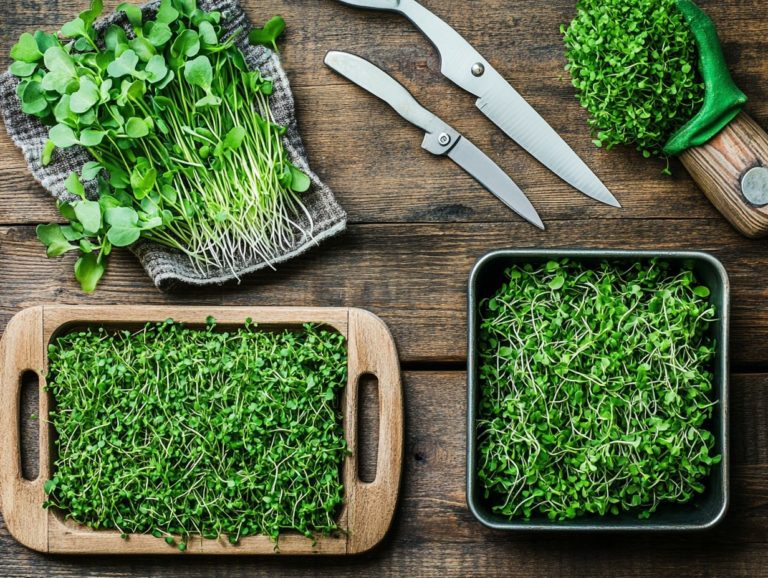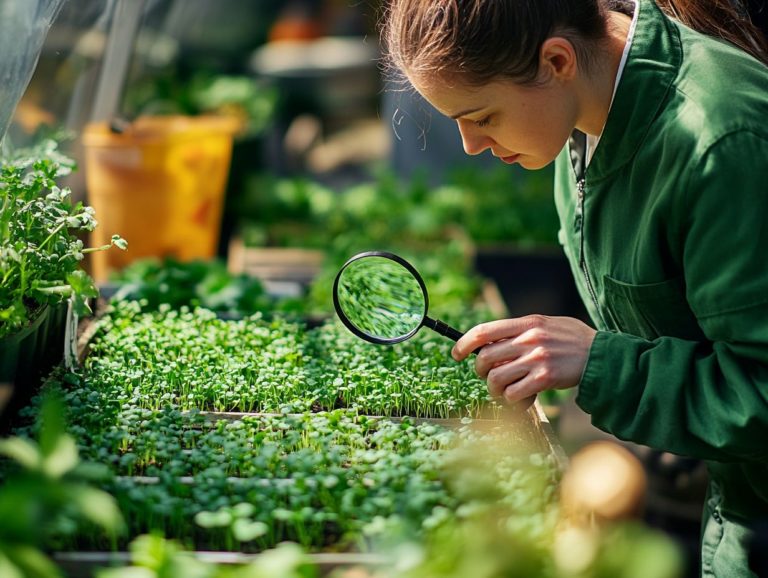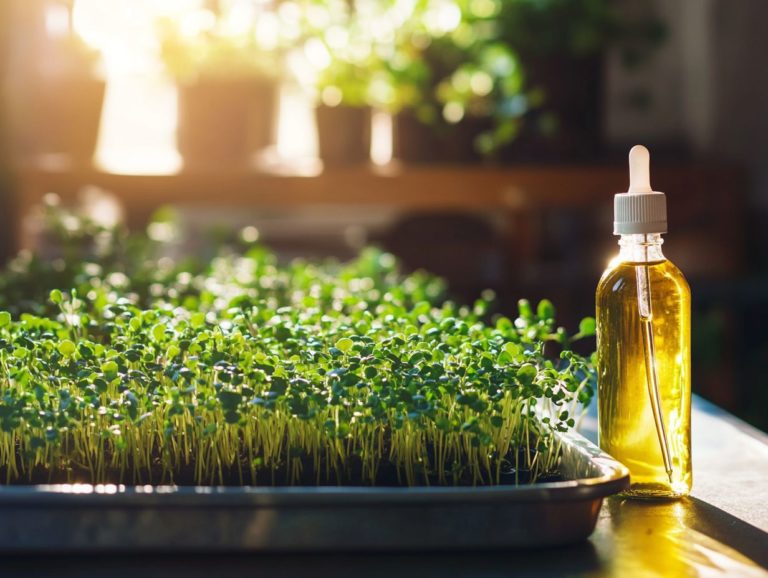Can I Reuse Soil for Microgreens?
Microgreens are popular for their vibrant flavors and impressive nutritional benefits. Many people grow them at home for easy access, often using worms to enrich the soil.
Soil plays a crucial role in nurturing microgreens. This article covers the essentials of microgreens, focusing on the importance of soil quality and nutrients.
Reusing microgreen soil can save you money and benefit the environment. However, be cautious of potential contamination risks.
You’ll discover practical tips for maintaining healthy soil. This ensures your microgreens thrive and flourish.
Contents
- Key Takeaways:
- Understanding Microgreens and Soil
- Benefits of Reusing Soil for Microgreens
- Potential Risks of Reusing Soil
- How to Properly Reuse Soil for Microgreens
- Steps for Preparing and Rejuvenating Soil
- Tips for Maintaining Healthy Soil for Microgreens
- Proper Hydration and Nutrient Management
- Frequently Asked Questions
- Can I reuse soil for microgreens?
- What are the potential risks of reusing soil for microgreens?
- How many times can I reuse soil for microgreens?
- What are the benefits of using fresh soil for microgreens, including home microgreens?
- Can I mix used soil with fresh soil for microgreens?
- How should I dispose of used soil from microgreens and consider gardening practices like composting soil?
Key Takeaways:
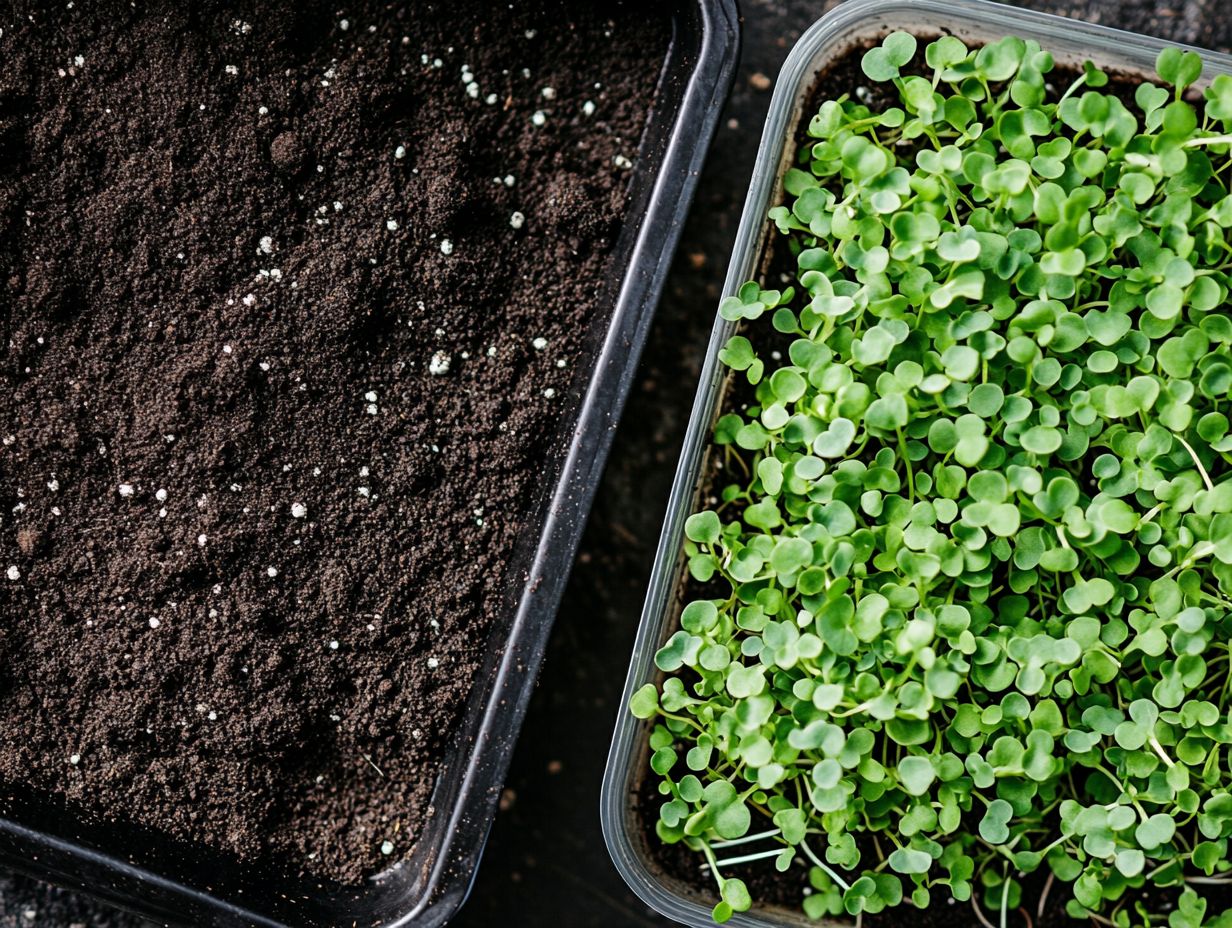
- Reusing soil for microgreens can lead to cost savings and have a positive impact on the environment.
- However, there are potential risks such as contamination and disease issues that should be considered before reusing soil.
- To properly reuse soil for microgreens, it is important to follow proper steps for preparation and rejuvenation, as well as maintain proper hydration and nutrient management.
Understanding Microgreens and Soil
Grasping the relationship between microgreens and soil is essential for anyone keen on cultivating microgreens at home. The quality of the soil significantly impacts the health and growth of various microgreen varieties, including Triton Radish, Wasabi Mustard, and Waltham Broccoli.
Using fresh, nutrient-rich soil is vital to fend off common diseases such as damping-off disease and E. coli, while also creating the ideal conditions for replanting microgreens. Following agricultural regulations keeps your garden thriving and enhances sustainability.
What are Microgreens?
Microgreens are the young, edible plants you ll want to harvest just after the first true leaves have emerged. Popular varieties like Triton Radish, Wasabi Mustard, and Waltham Broccoli each bring their own unique flavors and nutrients to the table.
Beyond their vibrant colors and bold tastes, these tiny greens deliver a remarkable nutritional profile, often boasting higher concentrations of vitamins, minerals, and antioxidants compared to their fully grown counterparts. For instance, peashoots are a treasure trove of vitamins A and C, while sunflower microgreens are packed with protein.
Whether you re a chef or a home cook, you ll appreciate the versatility of microgreens. They can enhance salads, elevate sandwiches, and even transform main courses. With their distinct textures and flavors, microgreens have become an essential ingredient in contemporary culinary practices, allowing you to take your dishes to the next level.
Importance of Soil for Microgreens
The importance of soil for microgreens truly cannot be overstated; high-quality microgreens soil, enriched with essential nutrients, is crucial for promoting healthy growth and maximizing yield.
This nutrient-rich medium acts as the foundation for your delicate plants, providing them with the necessary elements for photosynthesis, root development, and overall resilience. Microgreens thrive when the soil boasts an optimal balance of nitrogen, phosphorus, and potassium, along with trace minerals.
To enhance soil quality, you might consider various methods, such as incorporating compost, which not only boosts nutrients but also improves soil structure.
By using fresh, organic soil, you can create an ideal environment for your seedlings, allowing them to flourish and produce vibrant, nutrient-dense greens that satisfy consumer demands.
Benefits of Reusing Soil for Microgreens
Reusing soil for growing microgreens offers a range of substantial benefits, from cost savings to a positive environmental impact. By embracing practices such as composting soil and incorporating nutrient-dense worm castings, you can enhance both the health of your crops and the sustainability of your gardening efforts.
Save Money While Growing Healthy Microgreens!
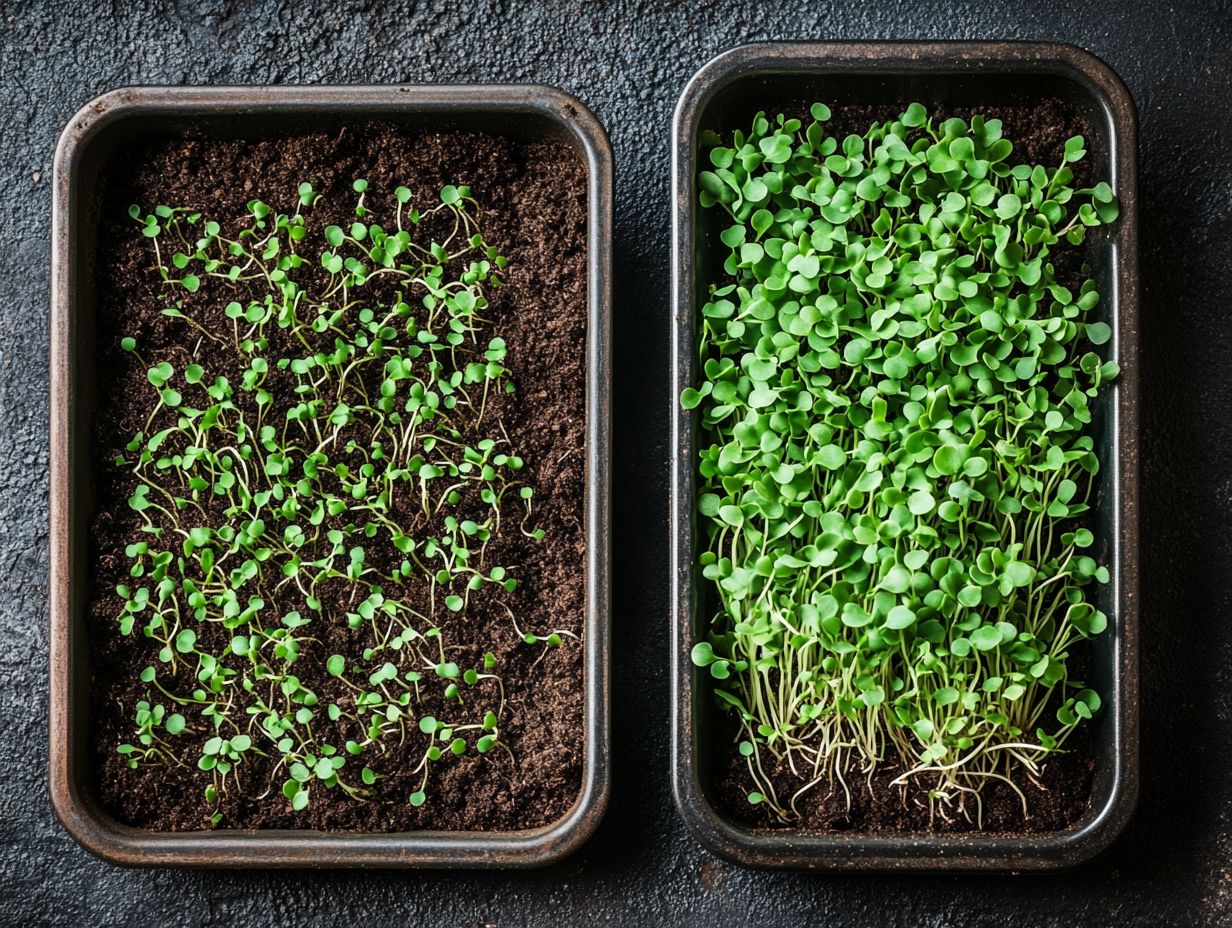
One of the most compelling reasons to reuse microgreen soil is the significant cost savings. This allows you to allocate funds toward other essential aspects of gardening or even explore new microgreen varieties.
By utilizing reclaimed soil, you can dramatically cut down on expenses related to purchasing fresh potting mix for every cycle. This practice enhances your budget efficiency and fosters a sustainable approach to gardening.
However, while reusing soil is economical, the importance of integrating fresh soil into your mix cannot be overstated. New soil introduces crucial nutrients and helps maintain optimal growth conditions. This ensures your microgreens thrive and produce high-quality yields.
Striking a balance between reusing and replenishing soil supports cost-effectiveness and promotes the longevity and vitality of your microgreen garden.
Grow Green: The Eco-Friendly Benefits of Reusing Soil
The environmental impact of reusing microgreen soil is significant. It aligns with sustainable gardening practices that help reduce waste and promote composting methods to enrich your soil.
By repurposing soil, you minimize the need for chemical fertilizers, which often leach into waterways and disrupt local ecosystems. This practice fortifies your soil with essential nutrients and enhances its structure and water retention capabilities.
Incorporating organic matter through composting creates a rich, fertile blend that benefits your future crops while reducing landfill contributions. Techniques like using worms to improve soil health or biochar can further elevate the health of your soil.
These eco-conscious strategies nurture healthier plants and cultivate a symbiotic relationship with the environment, turning your gardening into a proactive effort toward sustainability.
Potential Risks of Reusing Soil
Reusing soil for microgreens offers significant advantages, but it also poses certain risks that require careful consideration.
Issues like damping-off disease, pest contamination, and nutrient depletion may arise. Addressing these issues ensures a healthy growing environment.
Contamination and Disease
Contamination and disease present significant challenges when reusing soil. Pathogens like E. coli and pests can linger, potentially leading to outbreaks of damping-off disease among your microgreens.
Improper sanitization and lax prevention measures can amplify these risks, jeopardizing the health of your plants. Common contaminants such as fungal spores, nematodes, and heavy metals can infiltrate the soil from various sources, including previous crops or external pollutants.
If you want to cultivate microgreens successfully, adopt techniques like solarization or steam treatment to thoroughly sterilize your soil. Incorporating nutrients and organic matter helps establish a balanced ecosystem, promoting beneficial microorganisms while keeping harmful ones at bay.
Consistent monitoring and soil testing are vital to ensuring your microgreen garden flourishes.
How to Properly Reuse Soil for Microgreens
To effectively reuse soil for cultivating microgreens, especially through the method of using worms to improve soil health, adhere to these essential steps:
- Start by sterilizing the soil to eliminate any potential pathogens.
- Refine your soil preparation techniques to ensure optimal conditions for growth.
- Incorporate fresh soil or use the vermicomposting method to achieve an ideal nutrient balance.
This meticulous approach will enhance your microgreen cultivation and yield exceptional results. For more detailed guidance, check out our resource on how to choose the right soil for microgreen growth. Your gardening efforts will achieve the best possible outcomes!
Steps for Preparing and Rejuvenating Soil
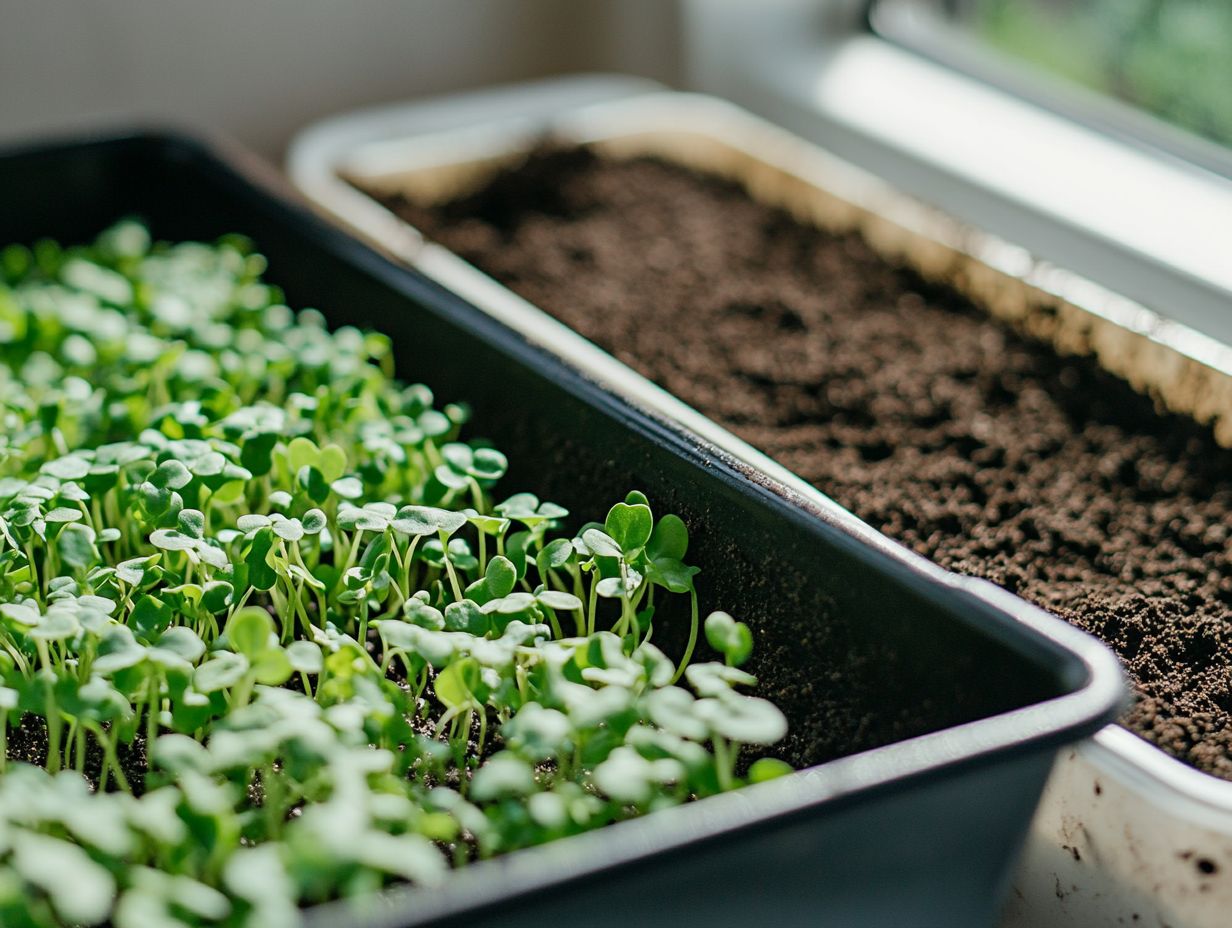
Preparing and rejuvenating soil for microgreens involves a series of essential steps. Start with a thorough examination of your soil quality. Add fresh soil or composting materials and use worm composting methods which utilize earthworms to turn food scraps into nutrient-rich soil to enrich the soil with worm castings.
Each action is vital for crafting a fertile environment where your microgreens can truly thrive. Assess the soil’s pH and texture to unveil its composition and suitability for planting. After this analysis, consider exploring soil alternatives for microgreen growing and incorporate organic compost to enhance the soil structure and deliver essential nutrients.
Taking it a step further, using worm composting allows you to harness earthworms’ natural processes, transforming kitchen waste into a potent fertilizer. This dynamic duo compost and worm castings works in harmony to promote robust and healthy growth in your delicate microgreen crops.
Tips for Maintaining Healthy Soil for Microgreens
To achieve optimal growth of your microgreens, it’s essential to maintain healthy soil. Keep an eye on key factors like hydration and nutrient management to help your microgreens flourish!
Proper Hydration and Nutrient Management
Proper hydration and nutrient management are crucial for maintaining high soil quality when growing microgreens, as they directly influence the plants health and growth rates.
To achieve optimal hydration, establish a consistent watering regimen that keeps the soil moist without oversaturation, which can lead to waterlogging too much water that can suffocate roots and stunt root development. Mixing high-quality organic compost with well-draining soil provides essential nutrients while helping to retain moisture.
Using a balanced fertilizer specifically designed for microgreens enhances nutrient availability, promoting vigorous growth and vibrant colors. It’s also important to choose the right growing medium; you can learn more about the best soil for microgreens. Using a moisture meter to check soil moisture helps you find the right balance, allowing for adjustments based on changing environmental conditions.
By prioritizing both hydration and nutrient accessibility, including composting soil and coconut coir, you can significantly boost the flourishing potential of your microgreens.
Frequently Asked Questions
Can I reuse soil for microgreens?
You can reuse soil for microgreens, but it’s best to limit it. This keeps your plants strong and healthy!
What are the potential risks of reusing soil for microgreens?
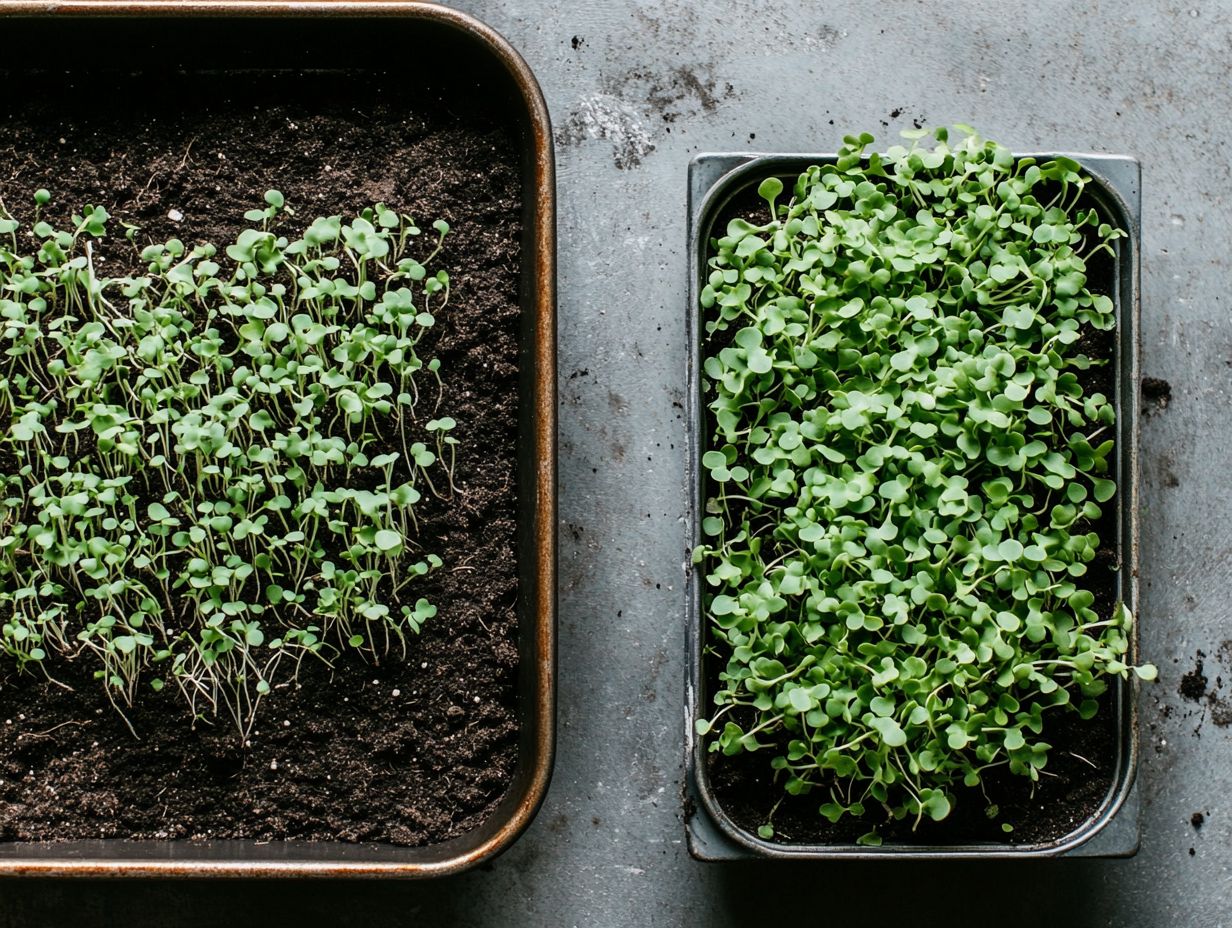
Reusing soil can increase the risk of contamination and disease in your microgreens. It can also affect the growth and overall health of your plants.
How many times can I reuse soil for microgreens?
The number of times you can reuse soil for microgreens depends on various factors such as the type of soil, growing conditions, and type of microgreens. It is generally recommended to only reuse soil once or twice and then replace it with fresh soil.
What are the benefits of using fresh soil for microgreens, including home microgreens?
Using fresh soil for microgreens ensures that your plants have access to essential nutrients and are not exposed to harmful microorganisms. It also promotes better growth and overall health of your microgreens.
Can I mix used soil with fresh soil for microgreens?
Yes, you can mix used soil with fresh soil for microgreens. This can help improve the nutrient content of the soil and reduce the risk of contamination. However, ensure that the majority of the soil is fresh and not reused.
How should I dispose of used soil from microgreens and consider gardening practices like composting soil?
If you choose not to reuse soil for microgreens, it is important to dispose of it properly. You can compost it responsibly or seal it in a bag for trash to avoid pests.
Start preparing your soil today for a bountiful microgreen harvest!



